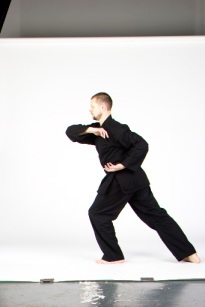When learning the basic Qi Dao movements, you will learn to use both hands, one performing the primary movement and the other performing the secondary movement. Qi Dao respects the philosophical principles of Yin and Yang common in Oriental schools of thought, which oppose as well as complement and balance each other. Like a magnet where the positive and negative poles cannot exist without each other, Yin and Yang movements need to work together to balance and synchronize the body and its energy field. In each spatial plane of movement, such as the sagittal (centerline), frontal (vertical) and transverse (horizontal) planes, there are directions having Yin or Yang qualities.
Yin movements represent the feminine aspect of universal energy flowing forward, downward and inward, each viewed in relation to one’s center. Yang movements represent the masculine aspect of universal energy flowing backward, outward and upward, again viewed in relation to one’s center. It is interesting to note that Western medical terminology uses the identical categories of direction: anterior – forward, inferior – downward, interior – inward, posterior – backward, exterior – outward and superior – upward.
The basic directional movements of Qi Dao are paired up in each of the spatial dimensions. When one arm performs a primary movement, the opposite arm makes a secondary movement to provide counter-balance. By definition, primary movement is a movement that coincides with the direction of the motion of the body’s center of mass. The power of the primary movement does not come from the tension of the arm muscles, but from the momentum of the whole body. By definition, secondary movement is usually the movement of the opposite arm in reverse. Most secondary movements have no inherent power because they move in the direction opposite to the momentum of the body.
Forward Push, Closing and Downward Press in this context require transverse motion of the legs – stepping towards the target with the opposite foot from the arm making the primary movement and bringing the weight on the front foot. Backward Pull, Opening and Upper Cut, on the other hand, usually require homolateral motion of the legs – stepping towards the target with the foot on the same side of the body as the arm making the primary movement. Imagine practicing these movements as if you are practicing Tai Chi – slowly and effortlessly. It will make your practice more meditative and pleasant. Qi Dao teaches that only harmonious steps can lead you to harmonious goals.
About the Author
Lama Somananda Tantrapa is the holder of the lineage of Qi Dao that has been fostered in his clan for 27 generations since 1224 AD. He has over 30 years of experience in Qi Dao and other internal martial arts. After pioneering Qi Dao Coaching in 2000, he has provided wellness, peak performance and life coaching to hundreds of clients from all walks of life. His coaching has inspired many professional athletes, speakers, dancers, singers, writers and actors to open up to the infinite source of power that exists within everyone.
Lama Tantrapa is the author of the bestselling book and DVD entitled “Qi Dao – Tibetan Shamanic Qigong.” Being an avid speaker and presenter, he appeared on many radio and TV programs in the US, Guam and abroad. For more information about Qi Dao Coaching, workshops, retreats, and long-distance learning opportunities, visit www.qidao.org.
